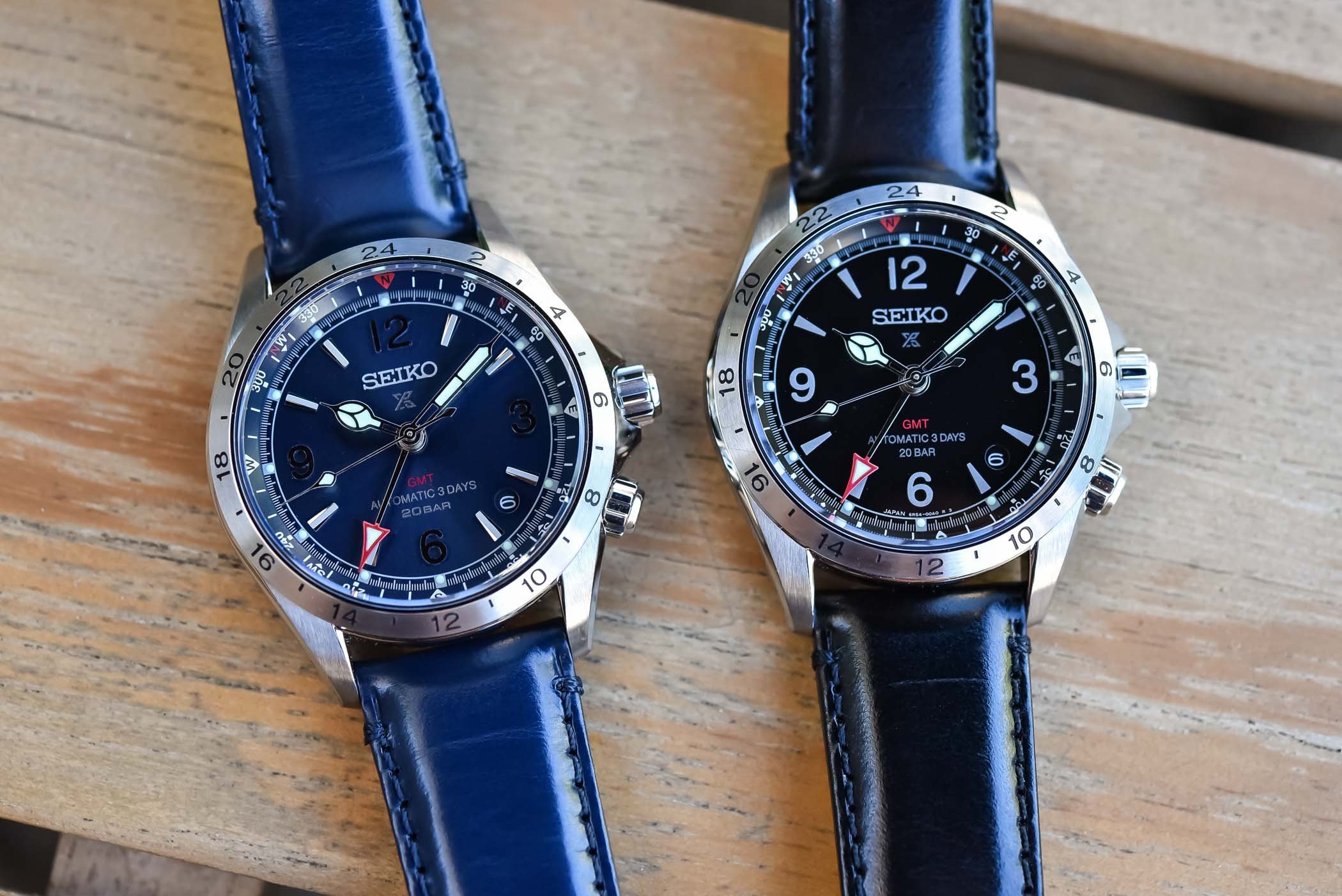The Seiko Prospex Alpinist SPB377 and SPB379, Even Better Now with a GMT Function
Seiko's emblematic adventure/exploration collection finally gets the complication it should have had from day 1: a dual-time display.

The name Prospex at Seiko, which stands for Professional Specifications, often brings to mind dive watches. Yet, it would be highly reductive to consider this collection as only focused on aquatic models. One significant name to be seen next to Prospex is Alpinist, a collection born in 1959, a watch specially designed for Japanese mountain climbers. Yet, it’s mostly under its modern shape that the Seiko Alpinist made a name for itself when the brand released a series of watches with an inner compass bezel in 1995. This so-called Red Alpinist (due to the red mark on the dial) has been available in various editions, including a dual-time version, however, only as a quartz-powered version. This year, in addition to the limited edition SPB409, Seiko finally gives its Alpinist a mechanical GMT movement with the new SPB377 and SPB379, creating the most compelling models in the collection.
The dual-time, traveller’s, GMT complication (whatever name you give it) seems to be the new obsession of Seiko. And we can’t blame the brand for that. We’ve seen it applied to a variety of watches recently, such as the entry-level Seiko 5 Sports, the Prospex 1968 Diver (surprisingly the first mechanical GMT dive watch of the brand), the Presage Style 60s or, in an unexpected comeback, within the re-edition of the Navigator. It was clearly time for the brand to bring this practical feature where it would make the most sense, inside its exploration/adventure watch, the Alpinist. Why is it that relevant on such a watch? We’ll get to that in a bit.
Looking at the modern face of the Seiko Alpinist, basically the style introduced by the brand in the mid-1990s when this watch received a rotating compass bezel with its dedicated additional crown, it feels natural to have such a dual-time function. It isn’t the first time that Seiko has implemented it within the collection, as the only existing traveller’s edition was a titanium perpetual calendar (the SBCJ0xx series) powered by a quartz movement. What we’re looking, besides the limited edition SPB409, are the first mechanical GMT Alpinist watches in regular production.
These new Alpinist GMT reference SPB377 and SPB379 are, at first sight, classic models with only a few differences to mark the evolution to a dual-time display. But then again, we need to avoid shortcuts as there’s more to these two references than just an additional 24-hour hand… Let’s start with the case. The Alpinist GMT is, without a doubt, an Alpinist… It retains the robustness we all expect from this collection, as well as emblematic features, starting with the additional crown at 4 o’clock to actuate the inner rotating bezel. The steel case, which is protected by a hard coating, measures a highly reasonable 39.5mm diameter, with a lug-to-lug measurement of 46.4mm. Compact enough for such a sporty watch, with enough presence too for the desired tool style. The screw-down crown and screwed back guarantee a solid 200m water-resistance.
There are some refinements though to be noted. The curved crystal is now sapphire and coated inside with anti-reflective treatment, the case feels a bit more posh with brushed surfaces and polished accents, including small polished bevels inside the lugs. The crown is fairly protected too, with elongated guards on the sides. The main difference with a traditional (non-GMT) Seiko Alpinist is, of course, the presence of a black-filled engraved 24-hour scale on the fixed brushed bezel. It’s a classic yet effective way to implement this function.
Moving to the dial, the new Alpinist GMT watches show a mix of tradition with some nice evolutions too. Classic features of the lineup have been kept, such as the luminous cathedral hands and the all-important rotating 360-degree compass bezel used to calculate directions. It’s a bit of a long story to explain how to navigate thanks to this bezel, but in short, it uses a combination of the position of the Sun and of the hour hand to determine the south, and thus the rest of the cardinal points (more on that here).
The Seiko Alpinist GMT comes in two tastes. The first, the most classic and utilitarian (SPB379), features a matte black dial with transferred markers and numerals in a silvery-white colour. The second adds a slightly more modern, fancy style (SPB377) with a sunray-brushed blue dial and raised markers and numerals. A point of difference with other members of the Alpinist family is the position of the markers and numerals, with Arabic markers at 3, 6, 9 and 12, while non-GMT versions have them for the even numbers. The circular date at 4:30, while a necessity on a GMT watch, could have been better integrated.
Now, the main difference… The central, red-tipped, arrow-shaped GMT hand. First, as with most dual-time watches from the brand, we’re talking about an office GMT, with this hand being adjusted independently. It’s not ideal, but in the context of an adventure, exploration watch, it’s less of a problem to me than a pure traveller’s model. Why…? Because of the utility of this hand on such a watch. Of course, having a GMT function on an Alpinist makes sense as you might have to use it when on an exploration on the other side of the globe – thus, you’ll be able to track your home time. But mostly, as was the case when Rolex first launched the Explorer II, this hand becomes extremely handy in conditions where you can’t differentiate day from night – for when you’re exploring the North Pole or underground in cave explorations. This GMT hand thus becomes a highly important day-night indicator. This is why the Alpinist GMT SPB377 and SPB379 are, to me, the most relevant watches in the collection.
Inside the case and visible under a see-through caseback is the well-known calibre 6R54, the same movement that is found in the Prospex 1968 Diver GMT or in the GMT Navigator Timer Reissue SPB411. This automatic engine beats at 3Hz and stores a comfortable 72h power reserve. The claimed accuracy (-15/+25 seconds/day) feels rather disappointing but we know that Seiko watches often perform much better than that.
These new SPB377 and SPB379 are worn on colour-matched leather straps with a folding clasp. While there’s nothing wrong with these, I feel that a more rugged strap would benefit the overall adventure-inspired design. A textile NATO band or a distressed leather strap would do justice to these watches. Nothing dramatic here, it’s just a personal thought.
Availability & Price
Now available from the brand, the Seiko Prospex Alpinist GMT SPB377 and SPB379 are part of the permanent collection and are priced at EUR 1,200. Overall, with the addition of this GMT complication, we certainly have some very cool adventure-ready models. Good looks, a good price (fairly less than the GMT diver), and good features… Not far away from a home run!
More details at seikowatches.com.














5 responses
This watch always should have had a GMT, it is a logical move in my mind, but it somehow waters down the distinctve alpinist look
I think a nice engraving instead of the display back would be preferable.
Beautiful watch. The GMT takes the design up a notch.
Nodus Sector GMT has the same movement, adjusted to +/-10s a day, for 475 USD on the hybrid rubber strap. Now let’s compare this to the presented Seiko…
This is a fantastic watch the limited edition white watch is absolutely fantastic, if you can get one 3000 pieces.